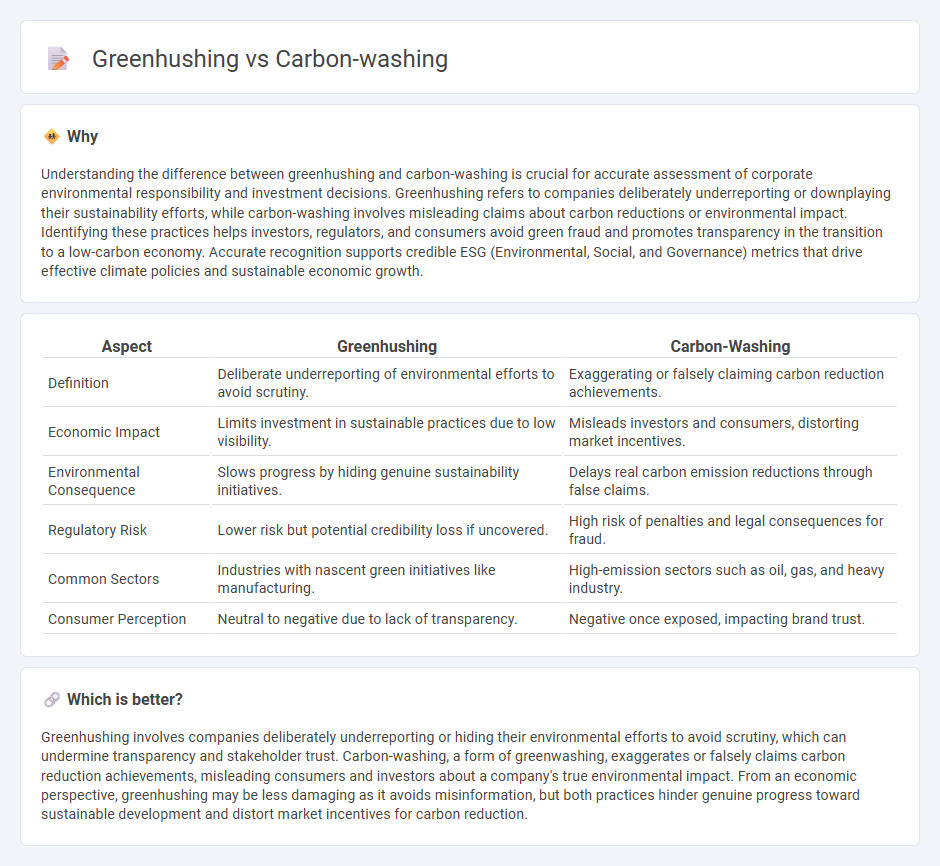
Greenhushing occurs when companies deliberately underreport or hide their environmental initiatives to avoid scrutiny, whereas carbon-washing involves exaggerating or falsely claiming carbon reduction achievements to boost public image. Both practices distort transparency in corporate sustainability, undermining genuine efforts to combat climate change and weakening investor and consumer trust. Explore further to understand how these tactics impact economic accountability and sustainable growth.
Why it is important
Understanding the difference between greenhushing and carbon-washing is crucial for accurate assessment of corporate environmental responsibility and investment decisions. Greenhushing refers to companies deliberately underreporting or downplaying their sustainability efforts, while carbon-washing involves misleading claims about carbon reductions or environmental impact. Identifying these practices helps investors, regulators, and consumers avoid green fraud and promotes transparency in the transition to a low-carbon economy. Accurate recognition supports credible ESG (Environmental, Social, and Governance) metrics that drive effective climate policies and sustainable economic growth.
Comparison Table
| Aspect | Greenhushing | Carbon-Washing |
|---|---|---|
| Definition | Deliberate underreporting of environmental efforts to avoid scrutiny. | Exaggerating or falsely claiming carbon reduction achievements. |
| Economic Impact | Limits investment in sustainable practices due to low visibility. | Misleads investors and consumers, distorting market incentives. |
| Environmental Consequence | Slows progress by hiding genuine sustainability initiatives. | Delays real carbon emission reductions through false claims. |
| Regulatory Risk | Lower risk but potential credibility loss if uncovered. | High risk of penalties and legal consequences for fraud. |
| Common Sectors | Industries with nascent green initiatives like manufacturing. | High-emission sectors such as oil, gas, and heavy industry. |
| Consumer Perception | Neutral to negative due to lack of transparency. | Negative once exposed, impacting brand trust. |
Which is better?
Greenhushing involves companies deliberately underreporting or hiding their environmental efforts to avoid scrutiny, which can undermine transparency and stakeholder trust. Carbon-washing, a form of greenwashing, exaggerates or falsely claims carbon reduction achievements, misleading consumers and investors about a company's true environmental impact. From an economic perspective, greenhushing may be less damaging as it avoids misinformation, but both practices hinder genuine progress toward sustainable development and distort market incentives for carbon reduction.
Connection
Greenhushing and carbon-washing both undermine authentic corporate sustainability efforts by obscuring environmental impact. Greenhushing involves companies deliberately minimizing or hiding their environmental claims to avoid scrutiny or regulatory backlash, while carbon-washing refers to exaggerated or false assertions about carbon reduction achievements. The connection lies in their contribution to consumer misinformation and the distortion of market incentives for genuine climate action.
Key Terms
Sustainability Reporting
Carbon-washing involves overstating or misrepresenting a company's environmental efforts to appear more sustainable, while greenhushing refers to intentionally downplaying or concealing sustainability achievements to avoid scrutiny. Both practices undermine the transparency and credibility of sustainability reporting, crucial for informed decision-making by stakeholders. Explore effective strategies to enhance authentic sustainability communication and reporting.
Corporate Social Responsibility (CSR)
Carbon-washing involves companies exaggerating or falsely claiming their efforts to reduce carbon emissions, misleading stakeholders about their environmental impact. Greenhushing refers to organizations deliberately downplaying or withholding information about their sustainability achievements to avoid scrutiny or backlash. Explore the nuances of CSR strategies and how businesses balance transparency and credibility in environmental reporting.
Regulatory Compliance
Carbon-washing involves companies exaggerating their environmental initiatives to appear more sustainable, while greenhushing refers to deliberately underreporting or hiding such efforts to avoid scrutiny or regulatory challenges. Regulatory compliance demands transparent, verifiable disclosures to ensure truthful communication of sustainability claims under frameworks like the EU Sustainable Finance Disclosure Regulation (SFDR) and the U.S. Securities and Exchange Commission (SEC) climate rules. Explore key strategies and legal requirements to navigate and align your corporate sustainability communication with evolving regulations.
Source and External Links
What is carbon washing? The latest greenwashing term you need to know - Carbon washing refers to companies falsely or exaggeratingly claiming to be environmentally friendly, leading to lack of accountability and enabling continued harmful emissions and environmental degradation.
A New Type of Carbon Data-related ESG Greenwashing - This paper explains carbonwashing as misrepresentation or selective disclosure of carbon emission data across reporting and verification stages, caused by methodological gaps and reputational incentives in sustainability finance.
Is Carbon Offset a Form of Greenwashing? - Earth.Org - Carbon washing occurs when companies emphasize carbon offsetting without prioritizing actual emission reductions internally, often using projects with limited verification that mislead public perception of genuine climate action.
 dowidth.com
dowidth.com